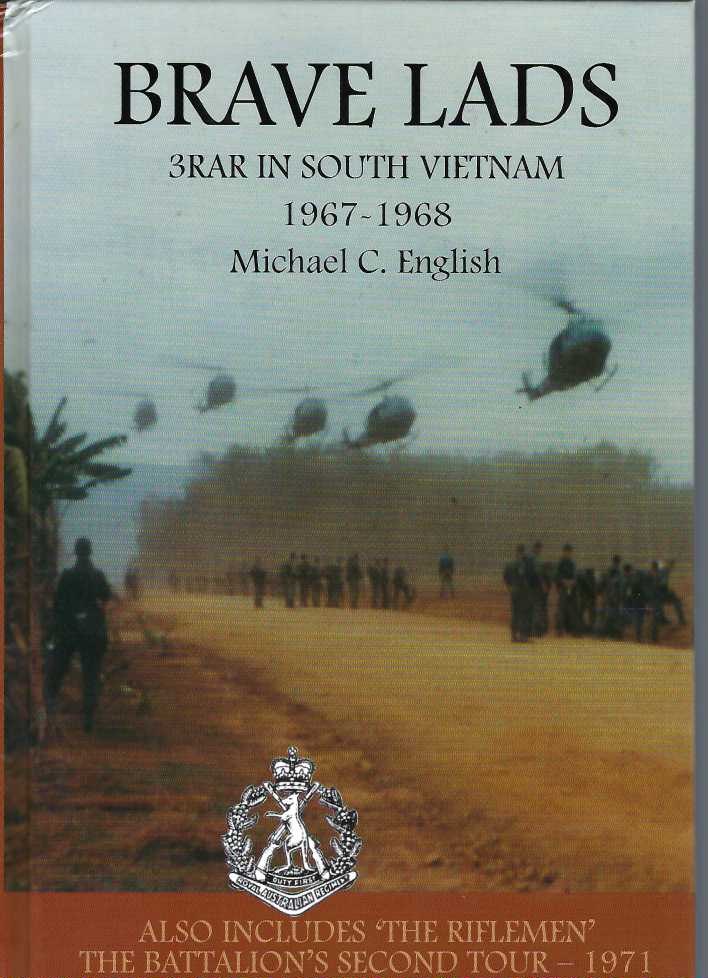Detailed history of the 3rd Battalion (The Royal Australian Regiment) in Vietnam 1967 to 1968.
‘Brave Lads’ is a long-awaited unit history that fills a gap in the Australian military experience in South Vietnam.
The Third Battalion, The Royal Australian Regiment (3RAR) first served in Vietnam in 1968 and later had a second tour of duty in 1971.
In 1968 3RAR was based at Phuoc Tuy Province but also operated outside their area of operation as the need dictated. The until fought in the Tet Offensive in early 1968 and later operated in the Long Hai Hills where it sustained many casualties as a result of mines.
In May-June of that year, the battalion successfully held off several determined enemy attacks at Fire Support Base ‘Balmoral’, and with the Australian military commitment at its height, the battalion continued its active patrolling and ambushing at a high level of activity.
The loss of men due to illness or wounds, or for any other reason, were not usually replaced, which placed a strain on those soldiers still serving on operation. In the second tour (1971) the battalion again encountered problems but despite that, the unit showed a high degree of professionalism in its actions against an ever-aggressive and sometimes elusive enemy.
This history pays tribute to the Brave Lads of 3RAR in their tumultuous year in Vietnam where hard work and ever-present danger, were constant companions.
This is actually a compilation of two books in one. The first title “Brave Lads” is a new publication, the second “The Riflemen: A History of the 3RAR Second Tour of Duty in Vietnam” was first published in 1999.
xiv, 325, x, 182 p. : ill., maps ; 25 cm. #141221
3 RAR served two tours in South Vietnam, the first from December 1967 with the battalion stationed in Phuoc Tuy Province as part of the 1st Australian Task Force.[14] The battalion took part in several operations and was involved in mine clearing, counter mortar and rocket tasks and reconnaissance in force operations. Between December 1967 and March 1968 Whisky Company from the Royal New Zealand Infantry Regiment was attached to 3 RAR as an additional rifle company for various phases of battalion operations. As the ready reaction force at the 1ATF base ‘A’ Company 3 RAR was responsible for clearing and securing the nearby provincial capital of Ba Ria (Phuoc Le) during the Tet Offensive of February 1968. The battalion was then committed to Operation Coburg in February and March.[15] During 26–28 May 1968, 3 RAR, while stationed at FSB Balmoral in a battalion defensive position, withstood two determined assaults by regimental sized units of the North Vietnamese Army during the Battle of Coral–Balmoral.[16] The battalion also played a role in Operation Toan Thang I in April–May 1968. During its first tour of Vietnam the battalion lost 24 killed and 93 wounded.[17][18]
On 8 May 1970 a group of soldiers from 3 RAR who had served in South Vietnam attacked 1,000 Moratorium marchers who were peacefully protesting against the war in Adelaide. This led to 21 soldiers facing disciplinary charges, including five who had been arrested by police and also faced civil charges.[19] The Army disciplinary heading led to at least 16 of the soldiers being fined or imprisoned for a short period.[20] At least three of the soldiers were convicted when their cases were heard by the Adelaide Magistrate’s Court; two did not receive a penalty and the other received a small fine.[21]
On 25 February 1971 the battalion returned to Phuoc Tuy Province. By 1971 American and Australian forces in Vietnam had reduced significantly and under President Nixon’s Vietnamization program U.S and allied forces undertook the process of handing control of the country back to the South Vietnamese forces and the Republic of Vietnam government. Communist forces took this opportunity to try and re enter areas that they had been previously forced out of earlier. This included the Australian and New Zealand Tactical area of responsibility of Phuoc Tuy Province. During the second tour the battalion took part in several actions and saw fierce fighting particularly in Battle of Long Khánh against well-trained North Vietnamese Army Regular forces before returning to Australia by the end of 1971 after an eight-month tour.[22] During these operations 3 RAR lost four killed and 27 wounded.[17][23]
